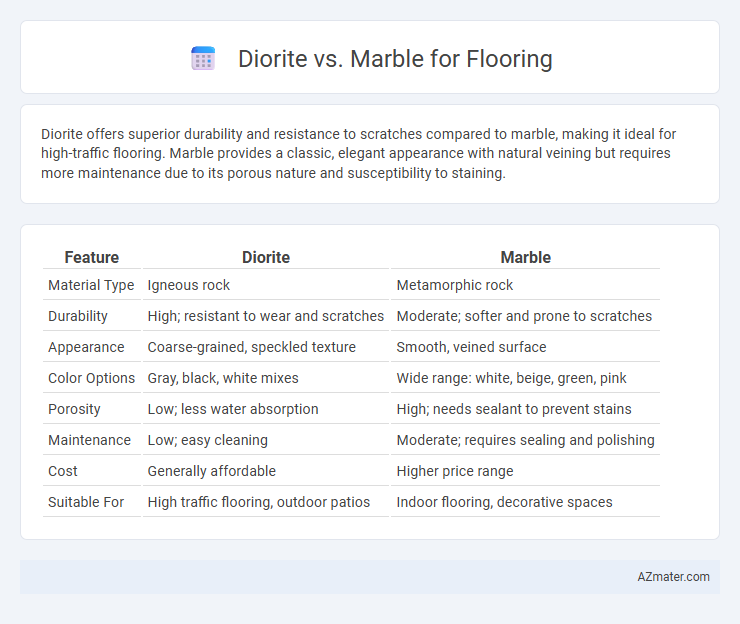Diorite offers superior durability and resistance to scratches compared to marble, making it ideal for high-traffic flooring. Marble provides a classic, elegant appearance with natural veining but requires more maintenance due to its porous nature and susceptibility to staining.
Table of Comparison
| Feature | Diorite | Marble |
|---|---|---|
| Material Type | Igneous rock | Metamorphic rock |
| Durability | High; resistant to wear and scratches | Moderate; softer and prone to scratches |
| Appearance | Coarse-grained, speckled texture | Smooth, veined surface |
| Color Options | Gray, black, white mixes | Wide range: white, beige, green, pink |
| Porosity | Low; less water absorption | High; needs sealant to prevent stains |
| Maintenance | Low; easy cleaning | Moderate; requires sealing and polishing |
| Cost | Generally affordable | Higher price range |
| Suitable For | High traffic flooring, outdoor patios | Indoor flooring, decorative spaces |
Introduction to Diorite and Marble Flooring
Diorite flooring offers exceptional durability and unique speckled patterns formed from intrusive igneous rock, making it a popular choice for high-traffic areas requiring long-lasting surfaces. Marble flooring is renowned for its luxurious appearance, featuring elegant veins and a smooth, polished finish derived from metamorphic limestone, ideal for creating sophisticated interiors. Both natural stones provide distinctive aesthetics and variable hardness, but diorite tends to be more resistant to scratches and stains compared to marble's softer texture.
Composition and Formation of Diorite vs Marble
Diorite is an intrusive igneous rock composed mainly of plagioclase feldspar, biotite, hornblende, and sometimes quartz, formed from the slow crystallization of magma beneath the Earth's surface. Marble is a metamorphic rock resulting from the recrystallization of limestone or dolomite under high pressure and temperature, primarily composed of calcite or dolomite crystals. The dense, interlocking crystal structure of diorite provides superior durability, while marble's calcareous composition offers a unique, elegant veining ideal for aesthetic flooring applications.
Aesthetic Differences: Appearance and Color Variations
Diorite flooring showcases a coarse-grained texture with a striking blend of black, white, and gray minerals that create a speckled, salt-and-pepper appearance, offering a bold and modern aesthetic. Marble flooring features smooth, elegant veining patterns in a wide range of colors from pure white and cream to deep green and black, providing a classic, luxurious look. The choice between Diorite and Marble depends on desired visual impact, with Diorite presenting a rugged, contemporary feel and Marble emphasizing timeless sophistication.
Durability and Hardness Comparison
Diorite exhibits exceptional hardness with a Mohs scale rating of approximately 7 to 7.5, making it highly resistant to scratches and wear, while marble, with a softer hardness around 3 to 5, is more prone to surface damage and etching from acidic substances. Diorite's dense, igneous composition contributes to its superior durability, offering lasting strength against heavy foot traffic and impact. Marble, though aesthetically elegant, requires more maintenance to preserve its surface integrity over time in flooring applications.
Maintenance and Cleaning Requirements
Diorite flooring requires minimal maintenance due to its dense, non-porous surface that resists stains and scratches, making it ideal for high-traffic areas. Marble demands more frequent cleaning and sealing because its porous nature absorbs spills and is prone to etching from acidic substances. Regular use of a pH-neutral cleaner protects both stones, while marble needs periodic professional polishing to maintain its glossy appearance.
Slip Resistance and Safety Considerations
Diorite offers superior slip resistance compared to marble due to its coarse-grained texture, making it a safer choice for flooring in high-traffic or wet areas. Marble's smooth, polished surface tends to be more slippery when wet, increasing the risk of slips and falls. For enhanced safety, diorite is preferable in environments requiring durable, non-slip flooring, while marble may require additional treatments to improve traction.
Cost Analysis: Diorite vs Marble Flooring
Diorite flooring generally costs between $10 and $40 per square foot, making it a more affordable option compared to marble, which ranges from $40 to $100 per square foot depending on the quality and origin. Installation expenses for diorite tend to be lower due to its hardness and durability, reducing long-term maintenance costs, while marble requires specialized installation and frequent sealing, increasing overall investment. Budget-conscious homeowners benefit from diorite's cost efficiency without compromising on natural stone aesthetics, while marble appeals to luxury projects due to its distinct veining and elegance despite its higher price point.
Environmental Impact and Sustainability
Diorite exhibits greater durability and lower porosity compared to marble, resulting in longer-lasting flooring that reduces the need for frequent replacements and minimizes resource consumption. Marble mining and processing generate higher carbon emissions and waste due to its softer nature and extensive finishing requirements. Choosing diorite for flooring promotes sustainable building practices by leveraging its resilience and lower environmental footprint throughout its lifecycle.
Suitability for Residential and Commercial Spaces
Diorite offers exceptional durability and resistance to wear, making it highly suitable for high-traffic commercial flooring, while its coarse-grained texture provides a unique aesthetic appeal for modern residential interiors. Marble's elegant veining and polished finish create a luxurious ambiance favored in upscale homes and boutique commercial spaces, though it requires more maintenance due to its susceptibility to scratching and staining. Both materials provide distinct benefits, with diorite excelling in robustness for commercial use and marble delivering timeless beauty ideal for residential elegance.
Conclusion: Choosing Between Diorite and Marble
Diorite flooring offers exceptional durability and resistance to wear, making it ideal for high-traffic areas, while marble provides a luxurious, elegant appearance with unique veining that enhances aesthetic appeal. Cost considerations reveal diorite as a budget-friendly alternative to the often pricier marble, which requires more maintenance to preserve its polished surface. Selecting between diorite and marble depends on prioritizing either long-lasting strength and affordability or sophisticated design and classic beauty for your flooring project.

Infographic: Diorite vs Marble for Flooring
 azmater.com
azmater.com